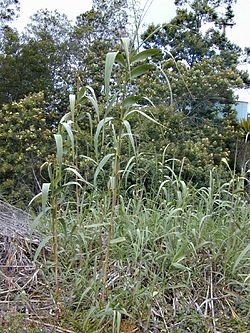Description
Arundo is native to southern Europe, North Africa, and much of temperate Asia as far east as Japan. [5] They grow to 3–6 m tall, occasionally to 10 m, with leaves 30–60 cm long and 3–6 cm broad.
- Species [4] [6]
There are over 200 species once considered part of Arundo but now regarded as better suited to other genera: [4] Achnatherum , Agrostis , Ammophila , Ampelodesmos , Arthrostylidium , Arundinaria , Austroderia , Bambusa , Calamagrostis , Calammophila , Calamovilfa , Chionochloa , Chusquea , Cinna , Cortaderia , Dendrocalamus , Deschampsia , Dupontia , Gastridium , Gigantochloa , Graphephorum , Gynerium , Imperata , Indocalamus , Melica , Miscanthus , Molinia , Muhlenbergia , Neyraudia , Phalaris , Phragmites , Poa , Psammochloa , Rytidosperma , Saccharum , Schizostachyum , Scolochloa , Stipa , Thysanolaena , Trisetaria .
This page is based on this
Wikipedia article Text is available under the
CC BY-SA 4.0 license; additional terms may apply.
Images, videos and audio are available under their respective licenses.
